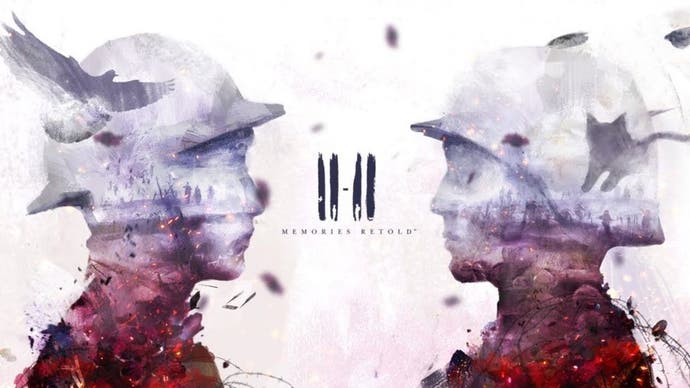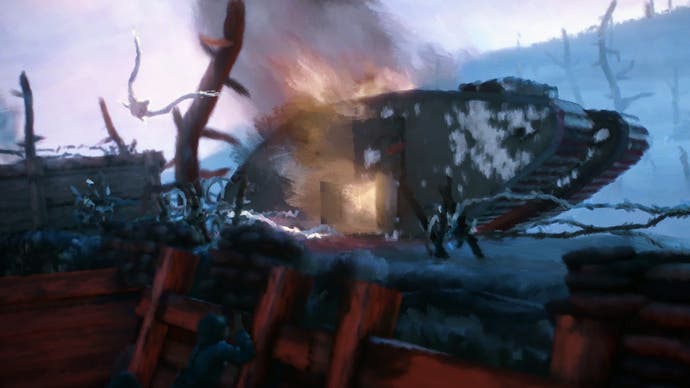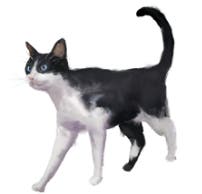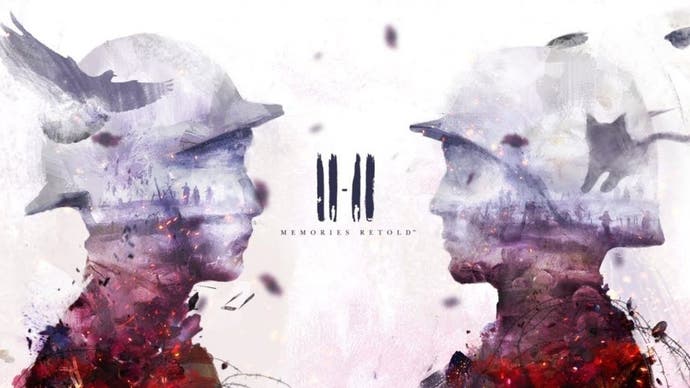11:11 Memories Retold, released today, is a WW1 game about normal people pushed into extraordinary events
Aardman's creative director discusses the game's influences - including impressionism, Brexit and cats.
We're fast approaching remembrance day on the 11th of November - but this year, the commemorative events will be of particular significance. 2018 marks 100 years since the end of the First World War, and to honour the centenary, Aardman (along with DigixArt) has done something a little unusual.
11:11 Memories Retold releases today on PC, Xbox One and PS4, and tells the story of two men who venture to the front lines to fight in WWI. One is British, the other German, and both have entirely separate reasons for signing up. It's a war drama that wants to give a more human perspective on a historical event often remembered for its industrial levels of killing - and it's doing so with an incredibly striking art style.
Aardman, of course, is the animation studio known for creating Wallace and Gromit and Shawn the Sheep - making it an unusual contender for a game developer. The studio has produced one smaller game before, but this is the first time it's taken on a larger development project. I spoke to the game's creative director from Aardman, Dan Efergan, about the challenges of the game's art style, and how the creators handled the complicated subject matter.

To start off - how are you feeling about the game's release?
Absolutely terrified. It feels so emotionally big to us all, and then personally as well, being able to release something of this scale. I'm trying to not worry about all the reviews coming out, but you still can't help it, it's like revealing your baby.
From when I look at it, I just see everything that's wrong with it, and I think it's like that for a lot of the team. It's quite nice watching other people talk about it and play it, and you start seeing it through other people's' eyes, and it starts looking different to what you see it as.
So has feedback been good so far?
Yes, so far really good. I always feels a bit clunky round the edges, but when people are playing it, they lock into the narrative and lock into the emotions. I think it's there - it feels to me that it's a bit chalk and cheese, some people just hate it and some people love it, but that I appreciate and quite like.
There was a Booker prize handed out for Michel Houellebecq, the guy who wrote Atomised, and when he was announced as the winner, half the audience stood up and started booing, and half the audience stood up and started cheering. I remember seeing that and going "that's it, that's what I want to do". Something that at least shifts people.

The game's art style is probably the most striking thing when you first look at Memories Retold, I was wondering what inspired the use of the "painterly" style?
The story of the whole game starts with a colleague of mine, Jake Manion, being over in Games for Change, where he started speaking to Yoan [Fanise, creative director]. The two realised they had very similar views about the world and the power of games and what they can be used for. This led to Yoan coming over and visiting a few weeks later (to the Aardman studios) to have a look around.
When he came over we gathered everything we could that we thought was relevant to show him, and one of the pieces was a video called Flight of the Stories, which was a piece we'd done for the Imperial War Museum to help promote their First World War exhibition for the beginning of the centenary. And that piece was inspired by the paintings of the turn of the century, the kind of impressionistic paintings which were happening at the time. That was the seed that kicked it off, but then Bram [Ttwheam, art director] continued to plunder from turn of the century all the way up to the wars. A bit of impressionism, but other painters, and a lot of Turner.
The techniques we used for this video were really intensive, some of the frames took 10 to 15 minutes to render, so it was not going to work in the same way if we were getting a real-time engine doing it. So we started looking at a slightly similar technique, which is oil-on-paints: an animation technique where someone keeps painting oil onto a single sheet of glass, and then only changes the bits that need to change, and before it's dry, keeps shifting and changing it and taking pictures in-between.
There were a few ambitious ideas where we wanted to play with more of the artwork that came out of the Great War, some of the brutalist and cubist movements - and futurism - and we really liked the idea of wrestling with those as well. There was this wonderful idea we had which if you were shell shocked that the whole world would collapse down in dimensions the way cubist paintings are, and you'd be trying to rebuild it again. But it was pointed out very politely by our producer that we were going to have enough trouble getting one art movement to work, so trying to re-build a whole system (particularly when Cubism doesn't respect the rules of physics) and underneath we still have a 3D physics engine controlling it all.
The impressionist art style is quite unusual in video games, where borders are normally quite defined - would you say you were able to create this shimmery and dreamy effect because the game isn't combat-focused?
It was driven by a belief and idea in what we were doing, and there's a sense of things being foretold. There's two techniques that both the individuals - Kurt and Harry - are using to communicate with you, the player, via this narration. One is letters home to communicate with his wife and daughter, while Harry is retelling his tale. Ultimately memories are quite subjective, and this underlies the whole game itself. We fought with the theme of it - because it shifted and changed as things do - but it took on its own life and we realised it's a lot to do with subjectiveness. The narrative doesn't give you a sense of right and wrong, it doesn't tell you who the goodies and the baddies are, it allows you to be subjective.
The music itself was based on these ideals, and Olivier [Deriviere, composer] always talked about these impressionistic composers like Debussy, and that was all based on the art style. The art style is an artistic impression - so you have to work, as well, to infer what that could be. All of those things seem to fit neatly together.
But yes, it can create some real nightmares when you say "please go and find me that thing," and that thing happens to be a small smudge of paint in the background. So gameplay and the technique were sometimes at loggerheads with each other, and one of the lengthy juggles we did was working out how to control those and still make it useful for a gamer to understand and interpret their world around them.
If you were trying to swing around and shoot something, you would probably need to know where it started and ended, and where it was coming from. At least because there isn't much agility needed in it, we can be more forgiving.

I noticed that animals play quite an integral part in the story (such as a cat and a pigeon). What's the thinking behind this?
They play a very specific purpose, as they are the spiritual representatives of each of the characters. It was also interesting to consider an animal's point of view of the war. War is a very human construct, and with the First World War you realise how non-ideological the conflict was - it was a bit confused, and a lot of people didn't really know why they were there. Unlike the narrative that has come out of WWII (although it was probably messy at the time), there was a sense of "this is an ideology I believe in or don't believe in, and therefore I am going to fight for this". A lot of people in WWI were there to fight for their country but didn't quite know what was going on.

So you've got this big political human constructed-weirdness that is forcing people to stand opposite each other trying to kill, but for an animal, those ideas of borders and structures and politics and war are abstract, and we liked being able to put the player in that point of view.
There were a lot of cats on the battlefront because there were lots of rats and mice, and they would walk from one side of the battlefield to the other and be fed by both British/Canadian and German soldiers, and again that was a Yoan thing of little unusual moments of humanness or "animalness" and therefore a point of view that was abstracted from the war.
How did the music, art style and story combine? The characters have their own musical themes and colour palettes, so was there a great deal of discussion in coordinating the characterisation?
It wasn't so much a top-down thing - I think there were just a lot of individuals who cared about emotion and character, so their drive was very similar. Bram wanted this sense of colour theory and was surprised that games didn't use it more. He believed we should be provoking emotions with colour, particularly because it's "painting-like". Therefore one of the techniques will be the colour of each of the characters, which will mix together when they meet and then drain out when they reach the front.
Olivier came on board, and although he'd already talked about characterisation quite a lot, I think that was reinforced by talking to Bram. For him, the music and the story and the art have to align, otherwise they're fighting against each other. A story the writers talk about quite a lot, which they find quite funny, is they got phone calls from Olivier talking about a particular story scene, and he would say "oh it's not really working with my music, can you change that story please" - so he was coming in and asking how he could make it work. Everyone was giving and taking to make sure everything pushed in the right direction for a particular emotion.
Something that convinced us Yoan was the right person was his approach to game design and the way he would try to base a particular scene on an emotion. He'd ask "how do you construct this emotion?" in the middle of a level or section of the game, and then at least you had something for everyone to hold on to - the puzzle designers, the pacing, the art. This game is driven by constructing the right emotions in people at the right time.

What kind of new perspective does the game bring to First World War art?
It felt like a very important story to tell - we're a hundred years on, the living survivors of the war are no longer around to directly tell their stories, and therefore the art and the work around these stories are important if we want to continue to pass down a story. Not just telling a grandesque Hollywood story, but quite an honest one with integrity that feels relatively truthful to the feeling of that war. It is a fictional story, but it's a fictional story that's been built with a backdrop of true historical places and facts. The nuances of the things that happened to the characters are inspired by all of these little moments from bits of documentation and historical artifacts, and pictures and postcards, and then the writers taking all of this and constructing their own worth within it - their own journey through that.
Yoan had a personal connection - he found a load of information on his grandfather and his great uncle, and it got him interested in the subject. He found the First World War a hugely inspirational event because it's about very normal people pushed into extraordinary events. The example he gave is that on one battlefield there was only one source of water, and there was this unsigned truce that no-one would shoot if you were going to get water. And so you ended up in this situation where people who were trying to kill each other 50m to the left or right were standing in a queue waiting to get water.
Ultimately, humans are humans, but we're so exposed to glorious Hollywood-esque battles that don't really portray reality. Probably the only people who would actually be like that are psychopaths - to want to kill that much - whereas humans tend not to want to. There are interesting facts about how many people in the war, and still in war, actually shoot their weapon. When they do aim at another human being, many just shoot into the air or the ground. Because we don't really want to kill each other, it's a natural thing.
I've got a slightly more politicised view. When I look around now at the world, it feels like we're becoming quite fragmented. There's a lot going on that seems to be isolating countries and cultures - Brexit is an obvious example here, there's walls being built between countries in other places, nationalism on the right. It feels very similar to the kind of environment that was starting to built before the First World War.
So it's really a game about humans and peace, just our tiny little offering amongst all this as a reminder of what we don't want to get back to.



